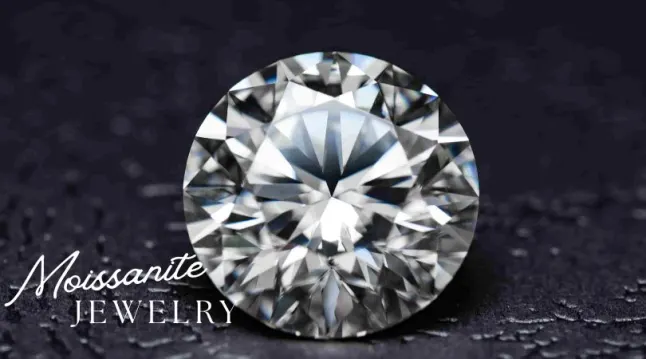Moissanite Engagement Rings Buying Guide
The use of a diamond has dominated the engagement ring market throughout living memory. However, what if you want an engagement ring with a similar look, but you don’t want to use a diamond? The good news is that you have options! There are several types of diamond “simulants" (stones that look similar to diamond, but have different chemical makeups). The most popular simulant used in engagement rings is called moissanite. A moissanite engagement ring can be a great alternative to a diamond ring, especially if you are looking for an eco-friendly or cost-effective option.
What is Moissanite?
Moissanite, composed of silicon carbide, is a gemstone that gives the illusion of a diamond, but is chemically and physically different. Since it’s a simulant, it is much less expensive but still gives off a lot of fire (sparkle) making it a good alternative to diamond jewelry. It is also very durable which makes it a top choice for diamond alternative engagement rings.
How was Moissanite Discovered?
Moissanite was first discovered in a meteorite in 1893 by the chemist Dr. Henri Moissan, after whom the mineral was named. Dr. Moissan quickly recognized physical similarities between moissanite and diamond. It turned out that the parallels between the stones were more than skin-deep. Actually, moissanite is more similar to diamond than other simulants in some respects which is why a moissanite engagement ring is a common choice if you don’t want to use a diamond.
Is Moissanite like Diamond?

Moissanite ranks close to diamond on the Mohs Scale of Hardness with a massive score of 9.25, while diamond maxes out the chart at 10. Moreover, the stability of moissanite when exposed to light, heat and chemicals, coupled with its resistance to scratching, means that it can be set by jewelers in any type of setting with just as much confidence as a diamond. As it is so durable, It is a great choice for engagement rings regarding daily wear and tear.
Is Moissanite a Natural Stone or Man-Made / Lab Grown?
Naturally-occurring moissanite only exists in small sizes, so almost all of the gem-quality material on the market is synthetic and sold as “synthetic moissanite.” This is a boon to individuals who are concerned about the environmental and social impact of mining. An additional benefit of synthetic moissanite is that it is priced at a fraction of the cost per carat of natural diamond. It can be synthesized to be colorless, but there is material that is slightly grayish, yellowish, or greenish in color. Typically, the larger the stone, the easier it is to see the slight tinge of color. Also keep in mind, if you bring your moissanite ring in for any service, the color may change when exposed to a jewelers torch. This is typically not permanent and will go back to normal once it cools down, but it’s always good to tell your jeweler that you have a moissanite center stone prior to any work being done.
Has Moissanite Been Around for a Long Time?
It sure has, moissanite engagement rings have been a long time diamond engagement ring alternative and are growing in popularity every day. In addition to moissanite rings, earrings and pendants are also great options since the material is so resistant to scratching and damage.
Will Someone Notice that my Moissanite is not a Diamond?
While synthetic moissanite looks very much like diamonds, and has historically fooled some diamond testing tools, there are optical differences. Gemologists consider three factors when evaluating the appearance of diamonds: fire (the flashes of color), brilliance (the flashes of white), and scintillation (the pattern of sparkle across the whole stone).
Moissanite has less brilliance than diamond, but has more fire. This means that the stone will reflect more rainbow colors than diamonds. However, nothing can compete with the adamantine shine and sparkle of a diamond, so if that is what you want from your rock, you may be disappointed in moissanite, and the larger the stone, the more visible this will be. However, if your “moissie” is set into a sparkly pave ring surrounded by diamond bling, I doubt the general gawker will notice at all.
What is a quick way to tell the difference between Moissanite and Diamond?
One of the quickest ways to tell if you are looking at moissanite versus a diamond is to check for doubling. Moissanite is doubly refractive whereas diamond is only singly refractive - this, along with the way it is cut, is why it has so much more fire. When you look through the bezel facet of a moissanite, you will see the facets reflecting twice rather than once like in a diamond (see the image below). This is very easy for someone with diamond training, but can be difficult for anyone else.
Why Would I Want a Moissanite Engagement Ring?
Moissanite rings are a great alternative to a diamond ring for several reasons. First, they can be produced in large sizes for a relatively low price. Second, they are thought to be more environmentally friendly than a diamond since there is no mining involved.
In addition to moissanite engagement rings, many people choose it for large stud earrings since they don’t get as much wear and tear like a ring does.
Is Moissanite as valuable as a Diamond?
No, a moissanite engagement ring will cost significantly less than a natural diamond ring. There are different qualities, but currently each retailer has a different standard for what makes a high quality moissanite ring.
Will Moissanite Pass on a Handheld Diamond Tester?
Yes, since it is a good thermal conductor like diamond, and that’s what a handheld diamond tester measures, it’s quite common for it to give a false reading as diamond. If you have a moissanite that tests as diamond, another quick way to check, aside from doubling, is to look and see if there is an inscription on the girdle. This can be done with a 10x jeweler’s loupe or even a high powered magnifying glass. Most every natural and lab diamond will have a laser inscription that matches the grading report whereas most moissanite will not.
Is Moissanite Graded the Same Way as a Diamond?
A diamond is graded based on its 4C’s (cut, color, clarity and carat weight). As of now, moissanite does not have a universal grading system like diamonds do. It is left up to the discretion of the seller, but most places will use a variation of the 4C’s to describe the material. For example, rather than a strict color grade, a seller will group moissanite into 3 categories: colorless, near colorless and colored (or something similar).
There are definitely different quality levels of moissanite, just like any other synthetic gemstone. For the best quality moissanite rings (or other jewelry), you want to purchase a colorless stone. You should also keep an eye on the inclusions (yes it has inclusions too) - going with “flawless” or “slightly included” will ensure you have the most fire and brilliance.
Wait, Moissanite Has Inclusions? I Thought it Would be Perfect Since it’s Synthetic.
Just like most every other synthetic gemstone, moissanite too has its own type of inclusions. The most common inclusions are needles (diamonds can have these too). These needles are often hollow tubes that can run anywhere within the stone. Typically, the material is eye clean with the needle inclusions only being visible with the use of at least 10x magnification. Other inclusions can include: cavities, crystals and feathers.
Does Moissanite weigh the same as a Diamond?
No, it weighs slightly less than a diamond and it’s typically listed with its actual size in millimeters rather than carat weight. If a stone is listed with a carat weight, it will be so in comparison to a diamond. For example, a 6.5mm round diamond typically weighs around 1 carat whereas a 6.5mm moissanite will be somewhere around 0.88ct.
What is the Next Best thing if I Decide I Don't Want a Moissanite Engagement Ring?
For a beautiful and economically wise option that you can enjoy for years, consider this alternative! If you decide you need that sparkle and shine, may we suggest spending just a little more on a lab-grown diamond; an affordable diamond option when compared to natural mined stones. Feel free to “ask a gemologist” at Rare Carat for help in building the right option for you!
A few final thoughts on Moissanite
- What is Moissanite?: It’s a synthetic gemstone composed of silicon carbide that looks very similar to a diamond. It has a hardness of 9.25 on the Moh’s scale which makes it very durable and well equipped as an alternative to diamond jewelry.
- All jewelry quality moissanite is synthetic (man-made).
- Moissanite will have more fire (sparkle) than a diamond, but doesn’t have the same adamantine finish (shine).
- Moissanite is doubly refractive, diamond is singly refractive. It’s also a good thermal conductor which means it can sometimes test as a diamond on a handheld diamond tester.
- Moissanite engagement rings are a great alternative to diamond rings, especially if you are looking for an eco-friendly option.
- Most moissanite is near-colorless, but can have tints of grey, yellow or green. Furthermore, most material is flawless to the naked eye, but some lower quality material could have some visible, needle-like inclusions.
- When looking for a good quality moissanite, try to find one that is colorless or near-colorless and “flawless” or ‘slightly included” for the most fire and brilliance.

